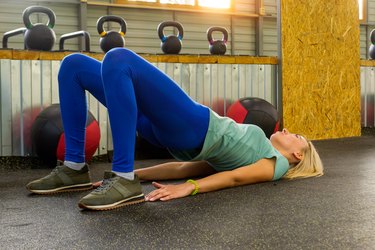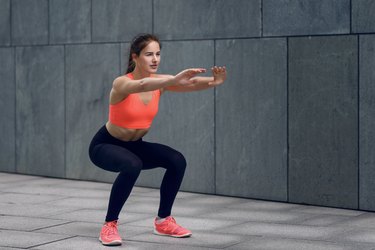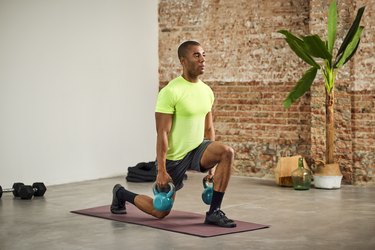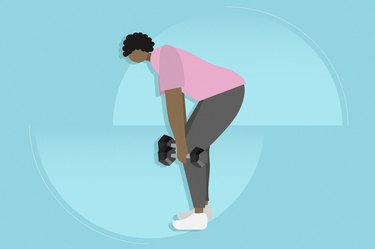
If you're new to running or looking to level up in the sport, you may be frustrated that you can't run as fast or long as you'd like.
You'll eventually get faster and be able to run longer just by logging regular miles, but if you want to learn how to increase running speed and distance, we've got you covered with specific techniques and tips that can help you along the way. Happy running!
Video of the Day
Warning
When working on speed and distance, listen to your body’s signals. Running beyond your capability could be dangerous.
1. Run Faster for Shorter Amounts of Time
Although adding miles will help you develop endurance (more on that below), scaling back mileage goals occasionally can help you focus on speed rather than distance, according to the American Council on Exercise (ACE).
You can add longer runs each week to work on distance goals, but be sure to plan recovery weeks with shorter runs so you can concentrate on improving speed. This way, you'll have the time and energy for speedier runs. Trimming your runs by a few miles should be sufficient to help develop speed bursts while maintaining progression on longer runs.
2. Incorporate Speedwork into Your Routine
Allocate time each week to focus directly on running faster aka speedwork or speed training. One example of speedwork is interval training. After a warmup jog of 10 minutes, run at a fast pace for 2 to 5 minutes and follow it with an equal recovery period at a slow or moderate pace. Repeat the cycle four to six times to develop speed, according to the ACE.
Another example of speedwork is Tabata training, which involves 20 seconds of high-intensity running followed by 10 seconds of recovery. Repeat this pattern eight times, per the ACE. (You can also do Tabata training outside of running, like a HIIT workout in the gym, for instance.)
Hill training is also great for improving speed. Run as hard as you can up the hill and then jog back down. Repeat this pattern several times, according to the ACE.
Can Wearing Lightweight Running Gear Boost Your Speed?
There are certain running shoes designed for speedier runs, according to Kaiser Permanente. They're typically sleeker and lighter weight so you can feel fast on your feet. In fact, a November 2016 study in Medicine & Science in Sports & Exercise found that wearing heavier shoes slows you down and worsens your running efficiency.
Wearing bulkier clothing like heavy jackets or lots of layers can also slow you down a bit, but it's important to take into account the weather you're running in. If it's cold outside, it's best not to sacrifice speed for warmth.
3. Increase Your Mileage and Slow Down Your Pace
Adding distance to your runs helps you work on your cardiovascular endurance, according to the University of Colorado Hospital. "Aerobic power helps an athlete sustain a challenging exercise pace over time. When you get tired, your movements are no longer fluid and efficient. You are more likely to make mistakes or get injured," according to the University of Colorado Hospital website.
Wondering how to increase your endurance and improve your stamina? Run for a longer amount of time. When doing this, it's helpful to slow down your running pace to help make your miles feel easier. So, if you typically run an 8-minute mile — which is about 7.5 miles per hour — you might slow down to a 9-minute-per-mile pace as you increase your mileage. Over time, you can work to bring your speed back up once your endurance improves.
A good running cadence is 85 to 90 strides per leg each minute, which helps to avoid tiring your body, according to Fleet Feet, a running store with more than 250 locations in the U.S. The more time your feet spend on the ground, the more weight your body must support. This can exhaust you more quickly, reducing overall mileage.
4. Strength Train
Even though there's no running involved here, incorporating strength work into your fitness routine can help you run faster and longer, according to the International Sports Sciences Association (ISSA). This is because you need strong muscles — especially in your lower body — to power each step you take.
Here are some lower-body exercises the ISSA recommends runners do to get stronger and run at a faster pace.
1. Glute Bridge
- Lie on your back with your arms resting by your sides, knees bent and feet flat on the ground hip-width apart. Your feet should be close enough to your hips that if you reach one hand at a time toward each heel, you can just touch it with your fingertips.
- Relax your arms alongside your body. Think of your shoulders being "glued" to the floor to help keep your spine neutral.
- Squeeze your glutes and core, and press your heels into the ground to drive your hips up toward the ceiling until you form a diagonal line from knees to hips to chest. Resist the urge to arch your lower back as you raise your hips. Focus on keeping your spine in a neutral position throughout.
- Hold this position for a few seconds with your glutes engaged.
- Slowly lower your hips back down to the ground and reset in the starting position for a second before lifting back up.
2. Clamshell
- Lie on one side. Stack your legs on top of one another, knees and hips bent at 90 degrees.
- Press your bottom leg into the floor and, with your heels pressed together, squeeze your glutes to raise your top knee toward the ceiling.
- Raise your knee as high as you can without letting your pelvis rock forward or backward.
- Pause, then slowly lower back to the starting position and repeat.
- Do all reps, then switch sides.
3. Air Squat
- Stand tall with your feet hip-width apart and brace your core. Focus on keeping your feet rooted into the ground and your core tight the entire time.
- Extend your arms out in front of you and slowly bend your knees as you push your hips back to lower toward the floor. Focus on lowering your body as if you were going to sit on a chair.
- Lower down as far as comfortable, or until your thighs are parallel with the floor.
- Pause for a moment at the bottom of your squat.
- On an exhale, reverse the motion by pressing through your heels to return to standing. As you stand, lower your arms back to your sides.
4. Forward Lunge
- Stand upright with both feet together.
- Step forward with one foot in front of your body. Take a big enough step that your front knee forms a 90-degree angle. Land with your front foot flat on the floor and grab the ground with your toes. Drive your back toes into the ground.
- Bend both knees and drop toward the floor with control. Keep lowering until your back knee is about an inch off the ground (or as low as comfortable). Keep your chest tall, but some forward lean is OK.
- Finish the rep by driving off the floor and returning back to your upright standing position. Bring your front foot back to your back foot.
5. Dumbbell Deadlift
- Stand with your feet hip-width apart, holding a dumbbell in each hand in front of your thighs, palms facing your body.
- Push your hips back behind you and soften your knees to lower the weights toward the middle of your shins.
- Check your posture: Your spine should be straight and long with your shoulders pinned back and down. The dip in your lower body should be very minimal. Brace your core to maintain this position.
- With your weight centered between your heels and balls of your feet, drive your feet into the floor to stand up as tall as possible. Imagine you are trying to push the floor away.
- Reverse the motion to lower the weights with control and repeat.
5. Listen to Your Body
When you're working to increase speed and distance, listen to your body's cues so you don't get hurt, and walk or stop running if necessary.
Stay hydrated during your run by drinking 7 to 10 ounces of fluids every 10 to 20 minutes if you're logging a significant amount of miles at a fast pace, according to the Mt. San Antonio College Department of Kinesiology and Sports Nutrition. Keep your body fueled by consuming 30 to 60 grams of carbs every 60 minutes, according to the National Academy of Sports Medicine (NASM).
For longer runs, listening to new music, tracking your heart rate on a personal monitor or running with friends can help you stay motivated.
How Long Does It Take to Increase Running Speed?
Unfortunately, there's no straightforward answer to this question. Everyone is different, and factors including genetics, the intensity of your training and the amount of time you can dedicate to running all play a role. According to the Cleveland Clinic, some people start to notice themselves getting faster in a few weeks, while it can take others up to four months to notice an improvement.
The important thing is to not give up. But don't ramp up your mileage too quickly if you're not seeing the results you want— that won't help. You should only increase mileage by about 10 percent each week so as to not injure yourself, per the Cleveland Clinic.
How many times a week should you run to improve speed? According to ACE, most training plans recommend running at least three days a week.
- ACE: "How Can I Increase My Running Speed for a Half-Marathon?"
- Fleet Feet: "What is Running Cadence and How Can You Improve It?"
- Mt. San Antonio College Department of Kinesiology and Sports Nutrition: "Hydration"
- NASM: "NUTRIENT TIMING: PRE AND POST-WORKOUT QUESTIONS ANSWERED!"
- University of Colorado Hospital: "Training for Cardiovascular Fitness"
- ISSA: "Exercises to Improve Speed: Training That Benefits Everyone"
- Kaiser Permanente: "The Best Running Gear for Race Day!"
- Medicine & Science in Sports & Exercise: "Altered Running Economy Directly Translates to Altered Distance-Running Performance"
- Cleveland Clinic: "How to Become a Faster Runner"
- ACE: "How to Train for a Half-marathon"
- Today: Running Farther, Faster and Longer Can Kill You




